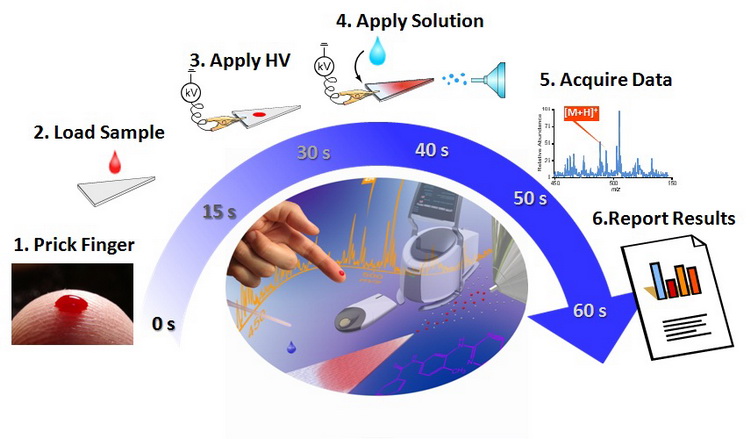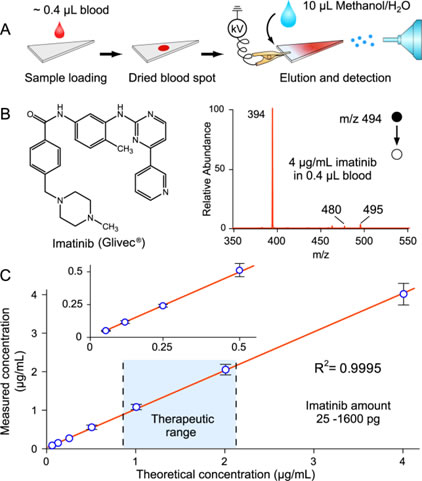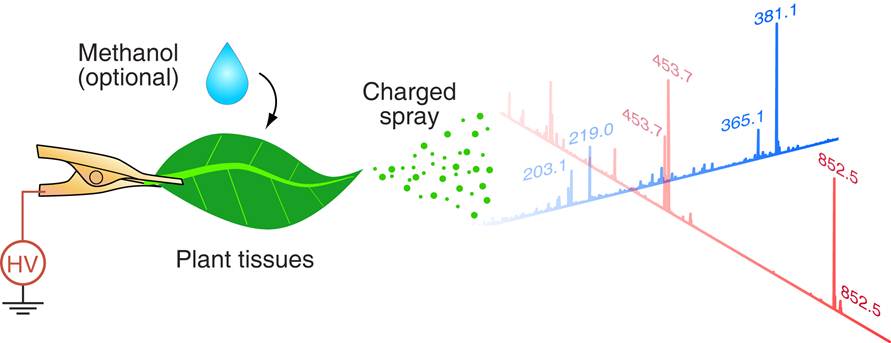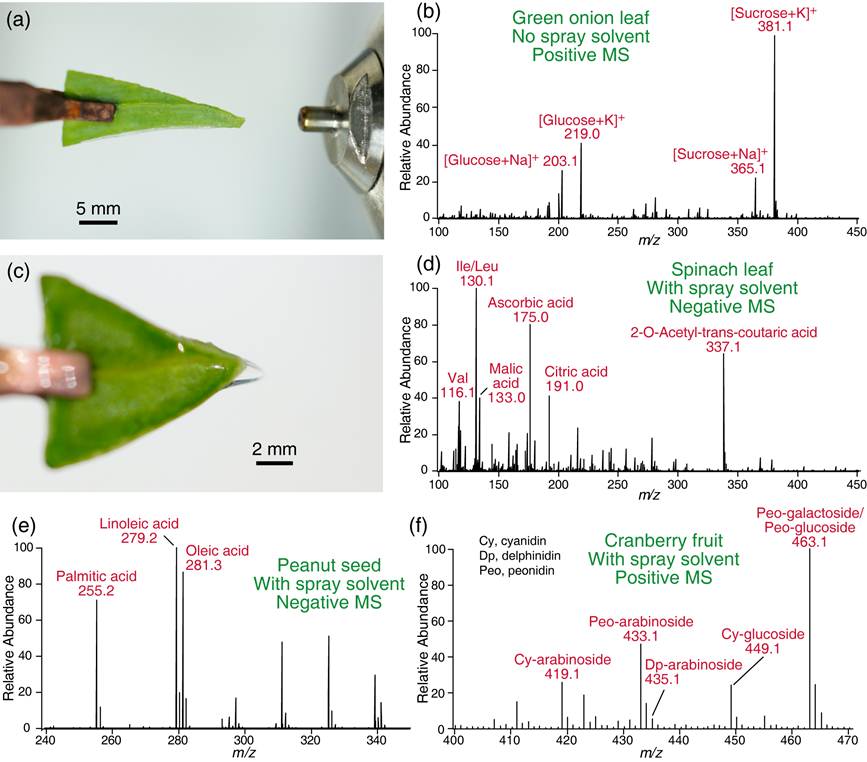|
| Paper Spray for Direct Analysis of Complex Mixtures using Mass Spectrometry |
|

|
| Paper spray is developed as a direct sampling ionization method for mass spectrometric analysis of complex mixtures. Ions of analyte are generated by applying a high voltage to a paper triangle wetted with a small volume (< 10 µL) of solution. Samples can be preloaded onto the paper, added with the wetting solution or transferred from surfaces using the paper as a wipe. It is demonstrated that paper spray is applicable to analysis of a wide variety of compounds, including small organic compounds, peptides and proteins. Procedures are developed for analysis of dried biofluid spots and applied to therapeutic drug monitoring with whole blood samples and to illicit drug detection in raw urine samples. Limits of detection of 50 ng/mL (or 20 pg absolute) are achieved for atenolol in bovine blood. The combination of sample collection from surfaces and paper spray ionization also enables fast chemical screening at high sensitivity, for example 100 pg heroin distributed on a desktop and agrochemicals on fruit peels are detectable. On-line derivatization with preloaded reagent is demonstrated for analysis of cholesterol in human serum. The combination of paper spray with miniature mass spectrometers offers a powerful impetus to wide application of mass spectrometry in non-laboratory environments. |
(A) Dried blood spot analysis on paper; 0.4 μL of whole blood is applied directly to a triangular section of chromatography paper. A DC voltage (4.5 kV) is applied to the paper wetted with 10 μL methanol/water (1:1 v/v). (B) Molecular structure of imatinib (Gleevec®) and paper spray tandem mass spectrum of 0.4 μL of whole blood containing 4 μg/mL imatinib which is identified and quantified (inset) by the MS/MS transition m/z 494 → m/z 394 (inset). (C) Quantitative analysis of whole blood spiked with imatinib (62.5 ng/mL - 4 μg/mL) and its isotopomer imatinib-d8 (1 μg/mL). Inset plot shows low concentration range. The bars represent the standard deviation of analysis for three replicates at different imatinib concentrations. |
 |
RIGHT: Comparison of nanospray with paper spray in the positive ion mode. (a) Optical images of the spray in nanospray and paper spray, showing generation of droplets at the tips of the glass capillary and paper triangle, respectively. Spray voltage: 2 kV for nanospray and 5 kV for paper spray. (b) Paper spray and nanospray show different molecular ion abundances (cocaine, 200 ng/mL, m/z 304) and different spray currents when increasing the spray voltage from 0.5 to 5.5 kV. Red lines: relative abundance of protonated cocaine; green lines: spray current. (c) Calculated survival ion yields for paper spray and nanospray. (d) Internal energy distributions for paper and nanospray. |
|
|
|
References:
- He Wang; Jiangjiang Liu.; R. Graham Cooks; Zheng Ouyang; "Paper Spray for Direct Analysis of Complex Mixtures Using Mass Spectrometry", Angewandte Chemie International Edition, 2010, 49, 877-880, doi: 10.1002/anie.200906314
- Jiangjiang Liu; He Wang; Nicholas E. Manicke; Jin-Ming Lin; R. Graham Cooks; Zheng Ouyang; “Development, Characterization, and Application of Paper Spray Ionization”, Analytical Chemistry, 2010, 82 (6), pp 2463–2471, doi:10.1021/ac902854g
- N. E. Manicke, Q. A. Yang, H. Wang, S. Oradu, Z. Ouyang and R. G. Cooks, "Assessment of paper spray ionization for quantitation of pharmaceuticals in blood spots", International Journal of Mass Spectrometry, 2011, 300, 123-129, DOI: 10.1016/j.ijms.2010.06.037
- H. Wang, N. E. Manicke, Q. A. Yang, L. X. Zheng, R. Y. Shi, R. G. Cooks and Z. Ouyang, "Direct Analysis of Biological Tissue by Paper Spray Mass Spectrometry", Analytical Chemistry, 2011, 83, 1197-1201, DOI: 10.1021/ac103150a
- Nicholas E. Manicke, Paul Abu-Rabie, Neil Spooner, Zheng Ouyang and R. Graham Cooks, "Quantitative Analysis of Therapeutic Drugs in Dried Blood Spot Samples by Paper Spray Mass Spectrometry: An Avenue to Therapeutic Drug Monitoring" , Journal of the American Society of Mass Spectrometry , 2011 , in press, DOI: 10.1007/s13361-011-0177-x
- Yang, Q.; Wang, H.; Maas, J. D.; Chappell, W. J.; Manicke, N. E.; Cooks, R. G.; Ouyang, Z. International Journal of Mass Spectrometry, In Press, doi: 10.1016/j.ijms.2011.05.013
|
| |
| Leaf Spray: Direct Chemical Analysis of Plant Material |
|
The chemical constituents of intact plant material, including living plants, are examined by a simple spray method that provides real-time information on sugars, amino acids, fatty acids, lipids, and alkaloids. The experiment is applicable to various plant parts and is demonstrated for a wide variety of species. An electrical potential is applied to the plant and its natural sap or an applied solvent generates an electrospray that carries endogenous chemicals into an adjacent benchtop or miniature mass spectrometer. The sharp tip needed to create a high electric field can either be natural (e.g. bean sprout) or a small nick can be cut in a leaf, fruit, bark, etc. Stress-induced changes in glucosinolates can be followed on the minute time scale in several plants, including potted vegetables. Differences in spatial distributions and the possibility of studying plant metabolism are demonstrated. |
 |
|
 |
| (a) Photograph of leaf spray ionization of green onion leaf cut to a point and held by a high voltage connector in front of the atmospheric inlet of a mass spectrometer. (b) Leaf spray spectrum acquired from green onion leaf in positive ion mode, showing sucrose and glucose ions. (c) Photograph of leaf spray ionization of spinach leaf in negative ion mode. The spinach leaf was cut into a triangle and methanol was applied on the leaf to achieve leaf spray ionization. (d) Leaf spray spectrum acquired from spinach leaf, showing amino acids and organic acids. (e) Leaf spray spectrum acquired from peanut seed in negative ion mode, showing three fatty acids. (f) Leaf spray spectrum acquired from cranberry fruit in positive ion mode, showing a series of phytochemicals. Assignments given are based on exact mass and/or MS/MS data. |
References:
J. Liu, H. Wang, R. G. Cooks and Z. Ouyang, "Leaf Spray: Direct Chemical Analysis of Plant Material and Living Plants by Mass Spectrometry", Analytical Chemistry, In Press. DOI: 10.1021/ac2020273 |


